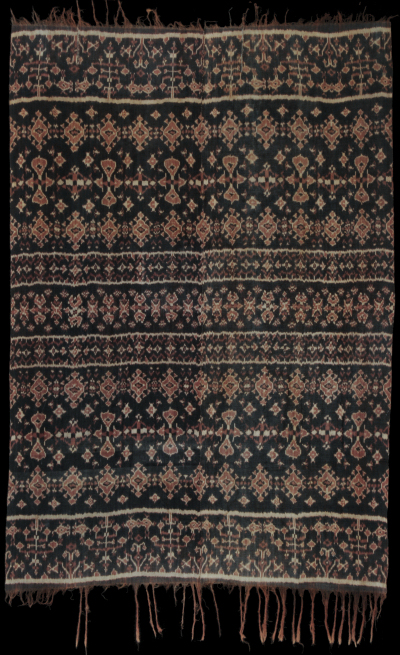| |
 
 | | | |
161 Flores Group, Ende
Semba (man's shawl)  
| | Locale: | Probably Ende proper. | | Period: | 1910-1930 | | Yarn: | Cotton, hand-spun, fine | | Technique: | Warp ikat | | Panels: | 2 | | Size: | 135 x 198 cm (4' 5" x 6' 5") LW: 1.47 | | Weight: | 665 g (23.5 oz), 249 g/m2 (0.82 oz/ft2) | | Design: | Patola inspired design with two very wide bands, two wide bands at the border, and two narrower bands enclosing the central bands, all made of of a wide range of small motifs, several of which recall jilamprang (or the Sumbanese patola ratu). Executed in morinda and white on very dark indigo, almost black, probably as a result of overdyeing. | | Comment: | Early 20th C. Ende man's cloth, semba. Exquisite, patola inspired, design influenced by that of Sumba hinggi - note the classic eleven-band lay-out, which is typical of Sumba hinggi from that period. Intricate motifs and tighter execution than common in the region show the hand of a master weaver. Absence of lateral borders points to creation after 1900. Two 15 cm tears with old repairs from one end border, otherwise in excellent condition. From old Dutch collection. | | Background: | Chapters on Flores Group and Ende. | | Exhibited: | Museu do Oriente, Lisbon, 2014/15 | | Published: |
Woven Languages, 2014.
Ikat Textiles of the Indonesian Archipelago, 2018.
| | Compare: | 100 | | Sources: | Field similar to semba from around 1900 in Khan Majlis, Indonesische Textilien, Wege zu Goettern und Ahnen, Fig. 373, but overall design (without the framing borders) similar to semba from around 1930, Fig. 371. Also similar to semba in Gittinger, Splendid Symbols, Fig. 127, but with addition of the two central bands with patola ratu motif. Also similar to 1930s semba in Völger & Von Weck, Indonesian Textiles, Fig. 135. Similar to pre-1940 semba in Tropenmuseum, Nr. 1772-1151, pre-1930 semba Nr. 719-2, and to Nr. 5856-1, dated as 'pre-1999', but probably from the early 20th C. and with more intricate and more varied design than the other two. | | |

©Peter ten Hoopen, 2025
All rights reserved.
|
|


